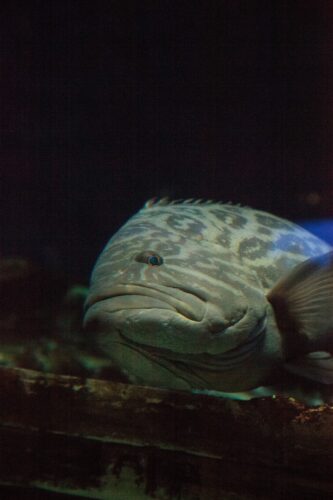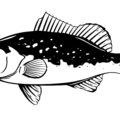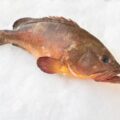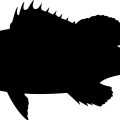The Mangrove Grouper (Mycteroperca xenarcha), sometimes known as the Broomtail grouper, is a ray-finned fish found in the eastern Pacific from California to Peru. This species favors estuaries with mangroves. Adults can be found up to a depth of 60 meters in shallow water, together with juveniles.
Classification of Broomtail Grouper
| Kingdom | Animalia |
| Phylum | Chordata |
| Class | Actinopterygii |
| Order | Perciformes |
| Family | Serranidae |
| Genus | Mycteroperca |
| Species | M. xenarcha |
| Scientific Name | Mycteroperca xenarcha |
| Weight | 30-60 Pounds |
| Length | 25″ – 59″ |
Description of Broomtail Grouper
A unique grouper species that is prized when fishing is the Broomtail grouper. From California (extremely rare) to Peru, they can be found all over the Eastern Pacific. As they grow bigger, filaments start to emerge from their tails, giving them their name.
Like the majority of grouper, they often inhabit reefs and, when hooked, will make a tremendous run to their preferred hole and break you off on the rocks if they can. The initial rush can permanently bury the rod’s butt deep in your gut if don’t have a lot of stamina and are ready for a fight. This is why even relatively big groupers frequently require pretty strong gear due to the amount of drag required to keep them from the home reefs. This species can weigh more than 100 pounds.
Despite their extensive distribution, they are not exceptionally numerous, and not much is known about them. When they are young, they are located in estuaries, but as they become older, they relocate to the inshore reefs, which end up becoming their permanent residence. They taste good, just like most groupers do. When hooked, Broomtails make a hasty retreat into their rocky homes, as most groupers do. You must make every effort to prevent them from reaching the rocks and breaking your line off during that first run since it is so powerful. Your chances of landing them improve if you get them off the bottom, but that first run is incredibly risky.

What to Look for in a Broomtail Grouper
The Broomtail grouper is distinguished by its general light brown coloration and by elongated dark brown blotches on its cheeks and sides that have a distinct center area that gives them the appearance of “lipstick kiss marks.” The gill covers of the Broomtail grouper have notches and are sharply serrated. The fish gets its name from its streamer-like margins on the tail fin. In addition to sea bass and other grouper species, the Broomtail grouper is a member of the Serrandae family.
Size and Diet
Despite having big mouths, Broomtail groupers don’t really have a high standard. Anglers frequently use their favorite crustaceans, such as shrimp or even a single squid, to entice them. The Broomtail Grouper is a grouper that will also favor live bait. As a result, some anglers take advantage of the situation by catching a smaller fish and then baiting it with Broomtail groupers.
Weights of Broomtail grouper typically range from 30 to 60 lbs. They are 25 to 59 inches in length on average. Typically, people capture fish that are around 2 feet long. Up until this point, a 4-foot, 10-inch Broomtail Grouper was the largest.
Environment and Distribution
However, the Broomtail grouper is a rare species, particularly in eastern California. They can usually be found in greater abundance in South American seas, such as those near Peru. Although Broomtail groupers prefer deeper waters, some do make their way to estuaries and mangrove swamps. In the Mexican Pacific, where there are many rocks, Broomtail groupers are frequently more prevalent. To ambush their prey, they frequently hide in rocky continental shores and reefs. The tendency to stay close to the surface is typically greater in younger animals. On the other hand, adults are commonly observed staying in water that is 196 feet deep.
Facts About the Broomtail Grouper
- When it comes to finding food, Broomtail Groupers may be highly opportunistic, just like their other Grouper kin.
- In North America, Broomtail groupers are thought to be uncommon. In South American seas, however, they are quite abundant.
- Currently, overfishing poses a threat to Broomtail groupers.
- Groupers with Broomtails have tender meat.
- Due to the challenge, many like fishing for Broomtail grouper.
Where to Find Broomtail Grouper
In the water column, these tough fish can be found on rocky reefs at depths ranging from 10 to 200 feet. The Broomtail grouper can be found in the Western Pacific Ocean from California all the way down to Baja Mexico and mainland Mexico.
These fish are strong fighters, and they frequently inhabit hard-bottomed parts of the continental shelf and the slope from nearshore mangrove areas. This species favors mangrove estuaries during the spawning season. In shallow water, both adults and juvenile fish are present at the same time; only the adults of the species migrate offshore to deeper seas.
How Large Can a Broomtail Grouper Grow?
The Broomtail grouper belongs to the Serrandae family, which also includes other grouper species and sea bass. The Broomtail Grouper is an incredible marine creature, with a wide variety of sizes that can be found in the wild. This species can grow to enormous sizes, reaching up to five feet in length and weighing over 100 pounds. The largest known Broomtail Grouper on record was caught off the coast of North Carolina and measured 4 feet 8 inches long and weighed 110 pounds.
Bottom Line
- Broomtail groupers are oval-shaped and quite sturdy, making them a powerful capture and a meaty fish. Even yet, some individuals are still able to confuse it for either a black grouper or a gag grouper. From mangrove areas to the hard soils of the continental shelf and the slope, Broomtail grouper can be found. It is said that it favors estuaries with a lot of mangroves.
- Although Mexican fisherman claim that there used to be more of them, Mycteroperca xenarchais, or broomtail grouper, is not endangered by fishing. The primary risk is habitat loss brought on by the eradication of mangroves.












Pingback: What is the Difference Between Grouper and Drum? | Reel Fishing Guru